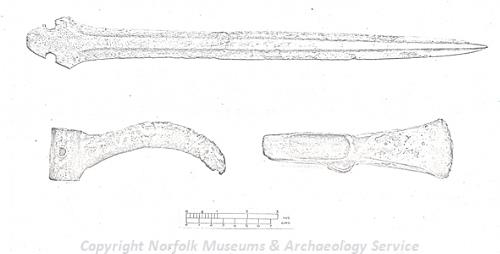This Parish Summary is an overview of the large amount of information held for the parish, and only selected examples of sites and finds in each period are given. It has been beyond the scope of the project to carry out detailed research into the historical background, documents, maps or other sources, but we hope that the Parish Summaries will encourage users to refer to the detailed records, and to consult the bibliographical sources referred to below. Feedback and any corrections are welcomed by email to heritage@norfolk.gov.uk
West Downham is a small Fenland parish in the west of the county. Downham comes from the Old English meaning ‘homestead on a hill’, and the parish is west of the market down of Downham Market. There is no village called West Downham, the settlement in the parish is called Salter’s Lode, an evocative Fenland name from the Old English meaning ‘place where salt is kept’, and ‘watercourse or drainage channel’. Salter’s Lode is a small hamlet, strung out along the road that hugs the drains and the course of the Ouse, with a few isolated farms standing out in the Fen.

A Middle Bronze Age hoard found in Downham West. (© NCC)
Two Palaeolithic handaxes (NHER
2435) have reputedly been found in the parish, as well as a Bronze Age hoard (NHER
4231), with a sickle, palstave and rapier, all made of copper alloy, which was found in the mid 19th century. Two other Bronze Age copper alloy palstaves (NHER
11958,
14342) have also been recorded.
It was during the Roman period that the parish became an important part of the salt industry on the Fen edge, an industry that gave the hamlet of Salter’s Lode its name. The Fen Causeway (NHER 2796), a Roman road that runs through the Fens to Peterborough, runs through the parish on a strip of silt that rises above the level of the peat. The road encouraged the exploitation of the Fens during the Roman period, and salt working became an important industry in this area. In 1993 the Norfolk Archaeological Unit excavated the site of a Roman salt works in Denver and West Downham (NHER 4235), which was visible as cropmarks on aerial photographs. The excavations revealed a series of enclosures, structures and turbaries. The excavation also found a ditched Roman field system, a canal and more salt working sites (NHER 4233), all dating to the 3rd and the 4th centuries. Roman coins (NHER 19920) and pottery (NHER 24476) have also been found by field walking, suggesting that Roman settlement and industrial activity was of a fairly high density along the Fen edge.
No Saxon finds have yet been recorded, and no settlement is recorded here in Domesday Book, but this area of the Fens was very important for Saxon settlements living on the Fen edges, as it provided summer pasture for livestock, driven down from the higher ground.
During the medieval period a hermitage was established, and is recorded in documents at the end of the 12th century. The exact site of the hermitage is unknown; it may have been located near Downham Bridge (NHER 12404), or near Bridge Farm (NHER 32958) where medieval masonry and a stone font have been found in the grounds. The Well Creek (NHER 14418) was constructed early in the medieval period, probably before the 13th century, to maintain a navigable channel to this area from King’s Lynn, where the Ouse estuary was slowly silting up. The New Podyke (NHER 14418) was built in 1422, and follows the course of the Well Creek.
During the post medieval period the Fens began to be systematically drained. In the early 19th century wind pumps (NHER 16332) were used to facilitate drainage, but by the mid and late 19th century they were replaced by pumping stations (NHER 40092). The pumping station was demolished in the 1950s when the new relief channel was constructed.
During World War Two a concrete pillbox (NHER 24478) was built on the banks of the Well Creek, and a spigot mortar emplacement (NHER 32959) was built to protect Downham Bridge.
Sarah Spooner (NLA), 27 October 2005.
Further Reading
Mills, A.D., 1998. Dictionary of English Place-Names (Oxford, Oxford University Press)
Rye, J., 1991. A Popular Guide to Norfolk Place-names (Dereham, Larks Press)